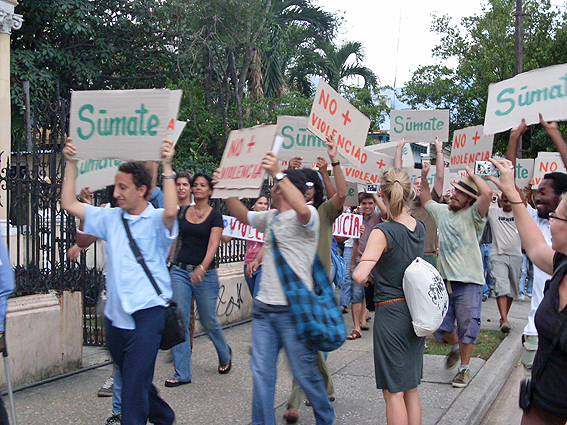The Havana March for Nonviolence: A Catharsis?
Regina Cano

A friend called me excitedly saying that word was going around that people were going to hold a march for nonviolence in downtown Havana; they would assemble on Friday the 6th at the corner of 23rd and G streets.
This had worried me because it could have generated the most violence seen in the last few years in Cuba – a concern I shared with two or three people I was able to contact.
Fortunately for everyone, nothing like that happened.
Nonetheless, I believe that with a minimum spark of provocation -a concern also held by some of the participants- a tremendous firestorm could have broken out, which would have produced a change in the spirit and backfired on the whole objective.
I later found out that other incidents associated with the demonstration generated a positive and justified digital stir, which was encouraging because solidarity is sorely needed.
These incidents captured the attention of everyone mainly as a wave of protest. But my question is: What’s up with the people? What’s happening with us as a people and the fact that we coexist with violence shared in daily acts?
Would a march under these conditions elicit reflection and induce some change within human beings concerning violence to engender a positive response in line with the aims of the demonstration?
Nonviolence is not inaction, but nor is it unconsidered action.
It’s not that I think conditions must be the exact for this to occur, but I do believe in the need for real transformation in the individual and their use of violence, or at least in the exhaustion of the use of all tools to attempt so.
I’m not in favor of certain forms of repression, and much less in stifling strategies. However, the organizers of this march only took steps along the asphalt, which could be repeated again and again in the same way with no real effect or impact on the cycle of violence, or it would be experienced only fleetingly.
For me it was an irresponsible act, a call for the attention of the international community to highlight the participants themselves.
My friends, this was only an act of epidermal passion that could have taken a good cause backward many more steps from where it could have been led.
Let’s not allow ourselves to be swept away by passion. Let’s not treat nonviolence with ingenuousness, if this was indeed ingenuousness. I insist on the need for training to be carried out, that conscious action be taken.
One must consider the need for a certain degree of consciousness of the fact that there are processes that take time to implement and that they can take longer than other parallel processes.
Rushed and cathartic actions are a small percentage of what is required, not the answer or the solution. What is most important is not “getting even,” it is the person and the damage that must be repaired with all of the best in people themselves drawing on their deepest inner forces. This can be affected with the energy and power that Cubans possess and with what really sustains this country.






“Non-violence” was not an abstract idea to Gandhi. It was a potent technique of engaging in trenchant, focused, active opposition to injustice. If I understand it correctly, it was a way of depriving an armed, dangerous state or other force of its excuse or pretext to use its overwhelming capacity for force to crush challengers. It was a way of defeating injustice.
The rhetoric of Marxism has always given the capitalist state a ready-made pretext for repression against all challengers–even against striking workers. It is difficult to believe that it was not imported into the socialist movement for any other purpose than to help destroy that movement.
We need non-violence, but we need it in order to end monopoly capitalism before monopoly capitalism destroys the world environment, and thereby ends civilization and perhaps human existence.
What was the point of this, indeed? As the other canadian (inadvertently) helped to bring out too: these sorts of demonstrations in support of abstract ideals essentially just end up going in circles. That is — they tend to end up serving reactionary ends.
As the author here points out — there should be some concrete purpose to this. I don’t even know what sort of “violence” they are referring to. Police violence? It wouldn’t likely be street crime, considering the sort of individuals involved, AFAIC. And AFAIC too: behind this, somewhere, there indeed lie other agendas. You don’t build socialism like this. But do all the participants really want to be building socialism, eh..?
whatever the organizers’ motives, or small first time organizing blunders, it seems to have had the effect of encouraging people to talk about it! and that’s important in a democracy, isn’t it?
(as a seasoned canadian rallier for everything from peace to an end to the destruction of ancient rainforests to an awareness of poverty and homeless issues, please accept my friendly advice: watch out for provocateurs who infiltrate such crowds and attempt to incite violence, to divide and conquer.)
relativenewz.ca